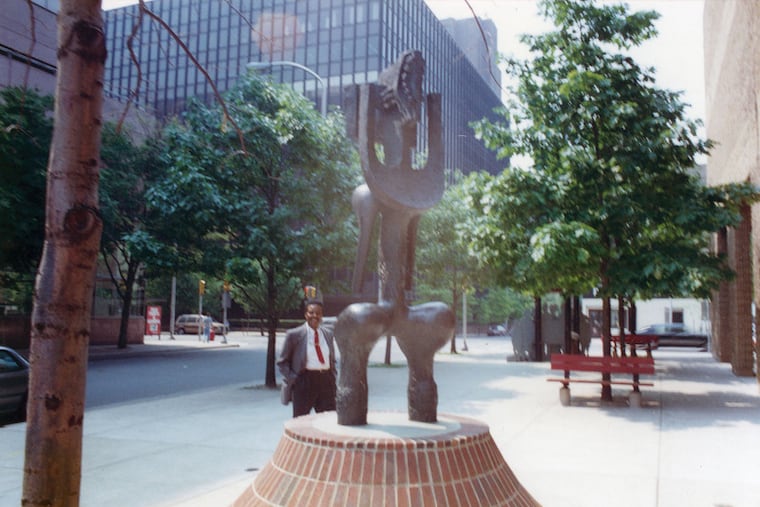One of John Rhoden’s Philadelphia sculptures is lost forever. Thankfully, another isn’t.
'Nesaika,' dedicated in 1976, stands right outside the African American Museum of Philadelphia.

You might not know much about John Rhoden’s Nesaika, but you have walked past it every time you have passed Seventh and Arch Streets. The 9-footbronze sculpture, which stands outside the African American Museum in Philadelphia, was dedicated on June 10, 1976, by Mayor Frank L. Rizzo.
Eight days later, on June 18, Rizzo inaugurated the museum, then called the Afro-American Historical and Cultural Museum. “AAMP was founded around the Bicentennial in 1976,” said Brittany Webb, the Pennsylvania Academy of the Fine Arts’ Evelyn and Will Kaplan curator of 20th century art and the John Rhoden collection. She is the curator of Rhoden’s first comprehensive retrospective that is now on view at PAFA, which has acquired 275 of Rhoden’s sculptures.
The name Nesaika, as is noted in the PAFA exhibit, “is derived from a Chinook jargon of a West African coastal trade language.” It means “we” or “a people.”
When Webb started on the Rhoden exhibit, the sculptor was often considered an underseen, unknown artist waiting to be discovered. “I immediately was sort of like, ‘No, you actually can’t work in large-scale bronze for a long time if you’re unknown,’ because it’s such an expensive medium,” she said. Rhoden, a Birmingham, Ala., born artist, had already attended Columbia University on the GI Bill, traveled the world on a Fulbright scholarship, and built public art sculptures for New York’s Bellevue and Harlem Hospitals, in 1972 and 1968 respectively, before the AAMP commissioned him.
“The original founders who were working on the founding of the museum had all of these ideas about how art and history should come together for the museum … and I think they chose Rhoden for this commission, because at the time, he was a known sculptor who had done [public art] commissions,” Webb said. “Black sculptors who had worked on large-scale public works at the time were not many. And [Rhoden] was somebody who was known to people who knew about African American art history before that was a known field.”
Public art has a way of assimilating itself among its surroundings. By design, it becomes a part of our landscape to a point where we often forget that it is, after all, art that is meant to be looked at, appreciated, and taken in. This is art that artists create in collaboration with commissions and officials who are not necessarily artists. Webb, who has served on public art commissions, concurs. “It is a lot to put artists through. They’re taking feedback from a lot of people who aren’t artists and aren’t makers, but have a lot of critical feedback on their work.”
The journey behind ‘Nesaika’
While at Columbia, Rhoden met artist Richanda Phillips who, in 1951, dropped out of college to travel to Italy with Rhoden on his Fulbright. They married in Rome in 1954 and later lived in New York’s Brooklyn Heights, where the couple would run art exhibitions in their living room and throw street fairs. “They had a four-story house, so Rhoden clearly was not like an unknown broke artist, he was able to support himself. And his public commissions were a huge reason why he was able to do that financially,” Webb said.
With Phillips, who was Native American, Rhoden traveled the world, studying Indigenous art, meeting artists like the Serbian sculptor Ana Bešlić, and training under Richmond Barthé. He developed an artistic style that departed from the conventions of contemporary American art.
What emerged was this idea of “one people out of many cultures.” In his notes on Nesaika, Webb said, Rhoden talks about where the figure comes from, and what his inspirations were. “He was thinking about Indigenous cultures. … And he had had an opportunity to spend a lot of time … [with] Indigenous artistic traditions that don’t show up in fine art spaces,” she added. He was inspired by pidgin languages and by the cire perdue wax-casting tradition he learned in West Africa.
The 1970s, Webb pointed out, were a time when Pan-African themes were showing up in the art world. “A lot of people were thinking, ‘What does this identity mean? Where does it come from? How much of this history don’t we know? Like, what does it mean to be this mix of people?’ ... and all of this shows up in Nesaika.”
The AAMP sculpture, however, isn’t Rhoden’s first in Philadelphia. Back in 1957, his Zodiacal Curved Wall adorned the walls of the old Sheraton Hotel at 1725 JFK Boulevard, as did three chandeliers he created. While those were lost to a remodeling project, one can still see Rhoden’s 9-foot sculpture of Frederick Douglass on West Chester’s Lincoln University campus.
PAFA’s retrospective of his works continues through April 7, but long after the show’s end date, Nesaika will still stand, reminding us to look and think about the art that quietly surrounds us — and the artists whose labor makes it possible.
A previous version of the article misidentified the Sheraton Hotel that housed Rhoden’s sculpture. It was housed in the former Sheraton at 1725 JFK Boulevard.